| 编辑推荐: |
本文主要介绍了Neo4j的使用与Java调用实例相关内容。希望对你的学习有帮助。
本文来自于微信公众号CSDN,由火龙果软件Linda编辑、推荐。 |
|
一. Neo4j简介:
Neo4j是一个高性能的,NoSQL图形数据库,它将结构化数据存储在网络上而不是表中。它是一个嵌入式的、基于磁盘的、具备完全的事务特性的Java持久化引擎,但是它将结构化数据存储在网络(从数学角度叫做图)上而不是表中。Neo4j也可以被看作是一个高性能的图引擎,该引擎具有成熟数据库的所有特性。程序员工作在一个面向对象的、灵活的网络结构下而不是严格、静态的表中——但是他们可以享受到具备完全的事务特性、企业级的数据库的所有好处。
在一个图中包含两种基本的数据类型:Nodes(节点) 和 Relationships(关系)。Nodes
和 Relationships 包含key/value形式的属性。Nodes通过Relationships所定义的关系相连起来,形成关系型网络结构。
相比其他NoSQL数据库,Neo4j的特点在于可以建立关系,达到数据关联的目的。从某些方面来说,我觉得它甚至可以取代关系型数据库,而且不需要事先定义表结构,字段扩展非常方便。
它使用的查询语言是Cypher。
二. Neo4j的核心概念:
1. Nodes(节点)
节点包含多个标签和属性,就像是一个地铁站。
一个节点就是一条数据。
2. Relations(关系)
关系是用来连接两个节点的,也可以包含多个标签和属性,就像是地铁站之间的线路。
一个关系也是一条数据。
关系包括进和出两种方向。
3. Properties(属性)
类似于关系型数据库里面的字段,不用事先定义,可以动态添加。
4. Labels(标签)
表示节点或者关系的类型,可以有多个,使查询更加方便和高效。
三. Neo4j的配置和使用:
下载最新的Neo4j:http://neo4j.com/download/
解压后移动到Neo4j下的bin目录,启动命令:neo4j.bat console
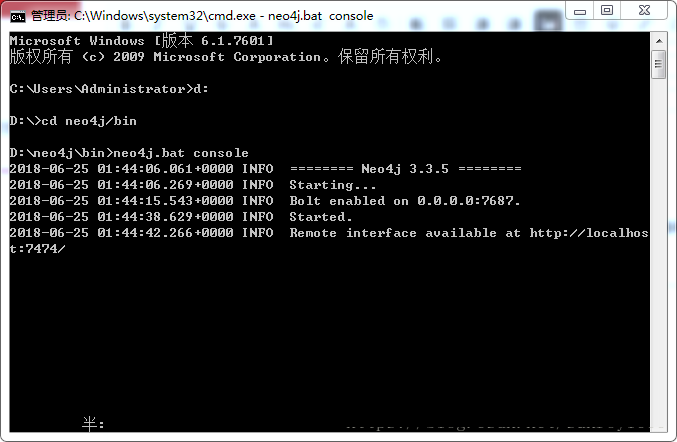
默认端口:7474
可在conf/neo4j.conf里面修改配置
在浏览器输入localhost:7474,登录Neo4j进行操作,默认用户名/密码:neo4j/neo4j,登陆后需要立刻修改密码。
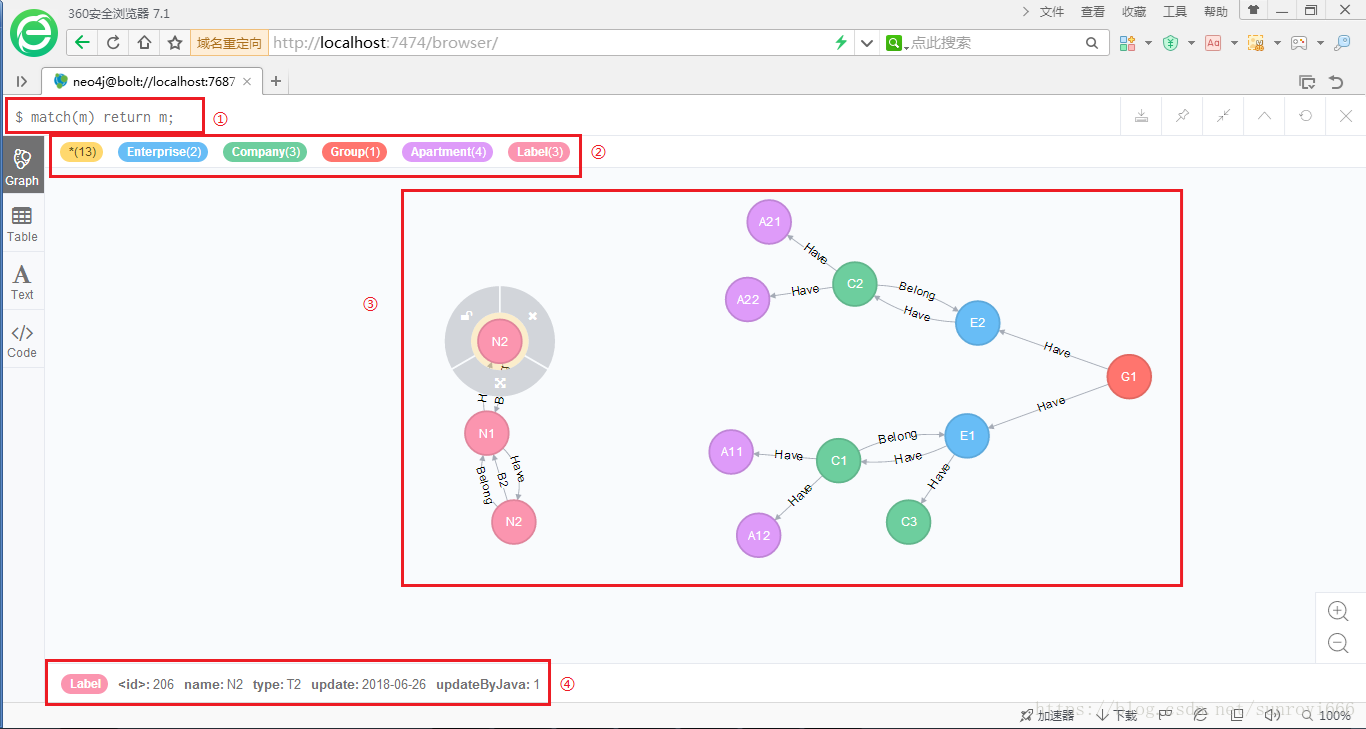
①:Cypher查询语句
②:各种Labels及其数量
③:节点和关系的图形界面
④:某节点包含的属性
四. Cypher的基本语法:
1. 创建节点:
CREATE
(n:Label {name:"L1", type:"T1"})
|
可以理解成:INSERT INTO Label(name, type)
VALUES("L1", "T1")
n是变量名,可以任意。Label是标签,可以有多个。{}里面是属性,可以有多个。
这个创建节点的例子中,包含了2个标签:
CREATE (n:Label:Test {name:"L1", type:"T1"})
2. 查找节点:
MATCH(a:Test)
WHERE a.name="L1" RETURN a; |
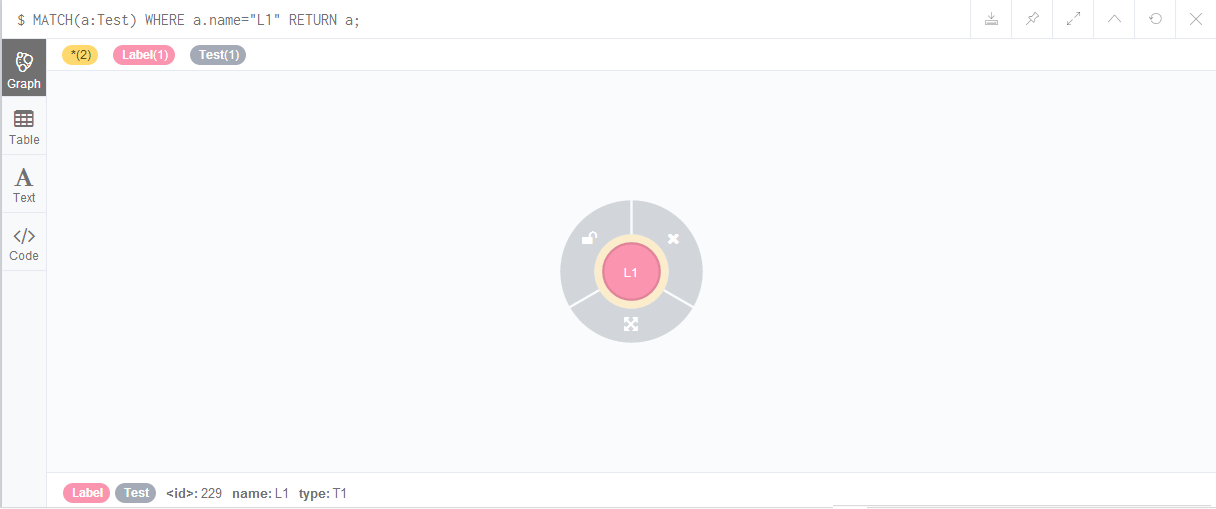
3. 创建多个节点和关系:
CREATE
(节点1),(节点2),(节点3),(节点1)-[关系1]->(节点2),(节点2)-[关系2]->(节点3)
|
例:CREATE (a:Node), (b:Node), (a)-[:Relate]->(b)
如果已有Node,只想添加关联,可用下面这种方法:
MATCH(a:Node),(b:Node) WHERE ID(a)=230 AND ID(b)=231
CREATE (b)-[:R]->(a)
4. 模式匹配:
根据关联进行数据查询。
MATCH
(a)-[:Have]-(b)-[:Have]-(c)-[:Have]-(d) WHERE
a.name="G1" RETURN a,b,c,d |
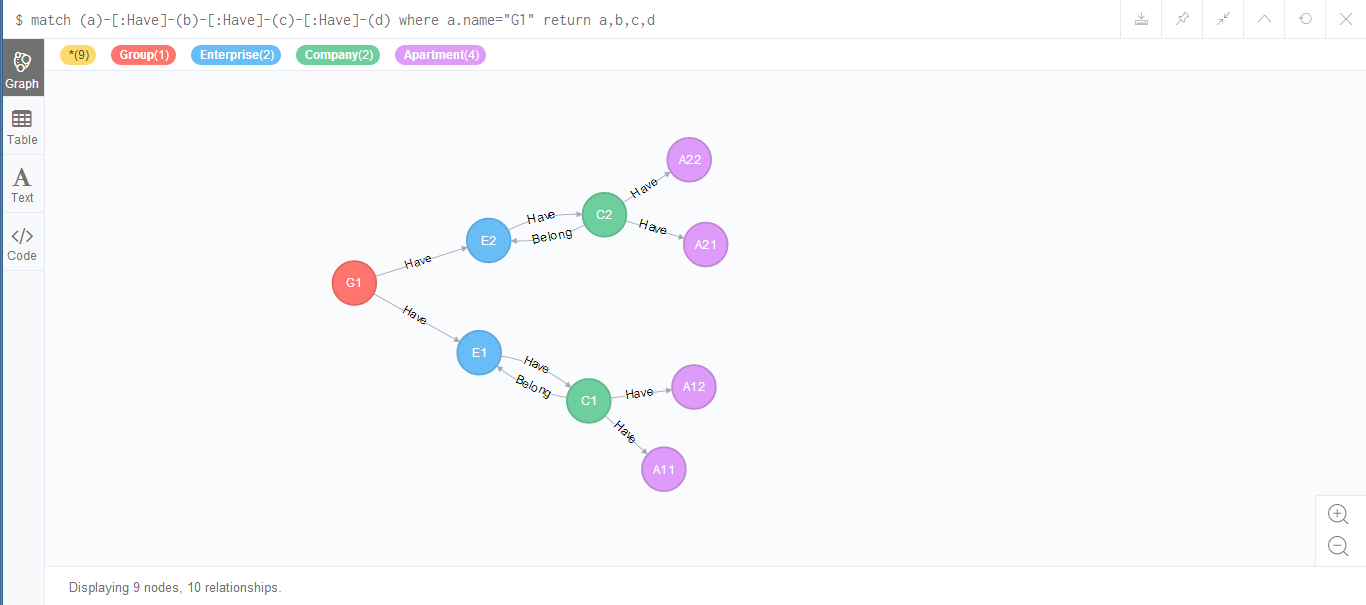
5. 更新节点:
MATCH(n:Label)
WHERE n.name="N2" SET n.update = "2018-06-26"
|
6. 删除节点:
MATCH(n) WHERE ID(n)=100 DELETE
n
|
7. 查看语句分析:
在查询语句前加上
或
五. Java实现的接口和实例:
我用的是SpringBoot的项目,可以直接启动ConsumerClientApplication,不用放到Tomcat下。
1. pom.xml中引入neo4j的jar包:
<groupId>org.neo4j.driver</groupId> <artifactId>neo4j-java-driver</artifactId> <groupId>org.neo4j</groupId> <artifactId>neo4j</artifactId>
|
2. 创建Code对象,用来传递参数:
package com.inesa.neo4j.entity; private String nodeFromId; private String nodeFromLabel; private String nodeToLabel; public String getNode() { public void setNode(String node) { public String getRelation() { public void setRelation(String relation) { this.relation = relation; public String getProperty() { public void setProperty(String property) { this.property = property; public String getLabel() { public void setLabel(String label) { public String getNodeFromId() { public void setNodeFromId(String nodeFromId) { this.nodeFromId = nodeFromId; public String getNodeToId() { public void setNodeToId(String nodeToId) { this.nodeToId = nodeToId; public void setId(String id) { public String getNodeFromLabel() { public void setNodeFromLabel(String nodeFromLabel) { this.nodeFromLabel = nodeFromLabel; public String getNodeToLabel() { public void setNodeToLabel(String nodeToLabel) { this.nodeToLabel = nodeToLabel; public String getWhere() { public void setWhere(String where) { public String getUpdate() { public void setUpdate(String update) { public String getResult() { public void setResult(String result) {
|
3. 创建Controller,添加接口:
package com.inesa.neo4j.controller; import java.util.ArrayList; import javax.servlet.http.HttpServletRequest; import javax.servlet.http.HttpServletResponse; import org.neo4j.driver.v1.AuthTokens; import org.neo4j.driver.v1.Driver; import org.neo4j.driver.v1.GraphDatabase; import org.neo4j.driver.v1.Record; import org.neo4j.driver.v1.Session; import org.neo4j.driver.v1.StatementResult; import static org.neo4j.driver.v1.Values.parameters; import org.springframework.web.bind.annotation.RequestBody; import org.springframework.web.bind.annotation.RequestMapping; import org.springframework.web.bind.annotation.RestController; import com.inesa.common.entity.RestfulResult; import com.inesa.common.utils.CommUtils; import com.inesa.common.utils.Constants; import com.inesa.neo4j.entity.Code; @RequestMapping(value = "neo4j") public class CodeController { private Driver createDrive(){ return GraphDatabase.driver
( "bolt://localhost:7687", AuthTokens.basic( "neo4j", "admin" ) ); @RequestMapping(value = "test") public void test(HttpServletRequest request,
HttpServletResponse response) { RestfulResult restfulResult = new RestfulResult(); Driver driver = createDrive(); Session session = driver.session(); session.run( "CREATE (a:Person {name: {name}, title: {title}})", parameters( "name", "Arthur001", "title", "King001" ) ); StatementResult result = session.run
( "MATCH (a:Person) WHERE a.name = {name} " +
"RETURN a.name AS name, a.title AS title", parameters( "name", "Arthur001" ) ); while ( result.hasNext() ) Record record = result.next(); System.out.println( record.get( "title" ).asString() + "
" + record.get( "name" ).asString() + " " + record.get( "id" ).asString() ); restfulResult.setResult(Constants.RESULT_STATE_ERROR); restfulResult.setMessage(e.getMessage()); CommUtils.printDataJason(response, restfulResult); @RequestMapping(value = "save") public void save(HttpServletRequest
request, HttpServletResponse response, @RequestBody Code code) { RestfulResult restfulResult = new RestfulResult(); Driver driver = createDrive(); Session session = driver.session(); StatementResult result = session.ru(an
( "CREATE :" + code.getLabel() + "
{" + code.getProperty() + "}) return a"); Record record = result.next(); restfulResult.setData(record.fields().get
(0).value().toString().replace("node<", "").replace(">", "")); restfulResult.setResult(Constants.RESULT_STATE_ERROR); restfulResult.setMessage(e.getMessage()); CommUtils.printDataJason(response, restfulResult); @RequestMapping(value = "update") public void update(HttpServletRequest
request, HttpServletResponse response, @RequestBody Code code) { RestfulResult restfulResult = new RestfulResult(); Driver driver = createDrive(); Session session = driver.session(); StatementResult result = session.run("MATCH
(a:" + code.getLabel() + ") WHERE a." +
code.getWhere() + " SET a." + code.getUpdate() + " return COUNT(a)"); Record record = result.next(); restfulResult.setData
(record.fields().get(0).value().toString()); restfulResult.setResult(Constants.RESULT_STATE_ERROR); restfulResult.setMessage(e.getMessage()); CommUtils.printDataJason(response, restfulResult); @RequestMapping(value = "delete") public void delete(HttpServletRequest
request, HttpServletResponse response, @RequestBody Code code) { RestfulResult restfulResult = new RestfulResult(); Driver driver = createDrive(); Session session = driver.session(); session.run( "match (n)
where ID(n) = " + code.getId() +" detach delete n"); restfulResult.setResult(Constants.RESULT_STATE_ERROR); restfulResult.setMessage(e.getMessage()); CommUtils.printDataJason(response, restfulResult); @RequestMapping(value = "search") public void search(HttpServletRequest
request, HttpServletResponse response, @RequestBody Code code) { RestfulResult restfulResult = new RestfulResult(); Driver driver = createDrive(); Session session = driver.session(); StatementResult result = session
.run("MATCH " + code.getProperty() + " MATCH " + code.getRelation() + " WHERE " + code.getWhere() + " RETURN " + code.getResult()); List<String> resultList = new ArrayList<String>(); while ( result.hasNext() ) Record record = result.next(); resultList.add(record.get("id").toString()
+ " " + record.get("name").toString()); restfulResult.setData(resultList); restfulResult.setResult(Constants.RESULT_STATE_ERROR); restfulResult.setMessage(e.getMessage()); CommUtils.printDataJason(response, restfulResult); @RequestMapping(value = "relate") public void relate(HttpServletRequest
request, HttpServletResponse response, @RequestBody Code code) { RestfulResult restfulResult = new RestfulResult(); Driver driver = createDrive(); Session session = driver.session(); session.run("MATCH
(a:" + code.getNodeFromLabel() + "),
(b:" + code.getNodeToLabel() + ") " + "WHERE ID(a) = " +
code.getNodeFromId() + " AND ID(b) = " + code.getNodeToId() + " CREATE (a)-[:" + code.getRelation() + "]->(b)"); restfulResult.setResult(Constants.RESULT_STATE_ERROR); restfulResult.setMessage(e.getMessage()); CommUtils.printDataJason(response, restfulResult); //private static final String
DB_PATH = "D:/neo4j/data/databases/graph.db"; //GraphDatabaseService graphDb; /*@RequestMapping(value = "save") public void save(HttpServletRequest
request, HttpServletResponse response, @RequestBody Code code) { RestfulResult restfulResult = new RestfulResult(); this.graphDb = new
GraphDatabaseFactory().newEmbeddedDatabase(new File(DB_PATH)); registerShutdownHook(graphDb); Transaction tx = graphDb.beginTx(); Node node = this.graphDb.createNode(); Label label = DynamicLabel.label(code.getLabel()); node.setProperty("Name", code.getProperty()); restfulResult.setData(node.getId()); restfulResult.setResult(Constants.RESULT_STATE_ERROR); restfulResult.setMessage(e.getMessage()); CommUtils.printDataJason(response, restfulResult); /* private void registerShutdownHook
(final GraphDatabaseService graphDB){ Runtime.getRuntime().addShutdownHook(new Thread(){
|
我这里只是做了几个简单的Sample,调用方式如下:
(1) 创建节点(save)

(2) 删除节点(delete)
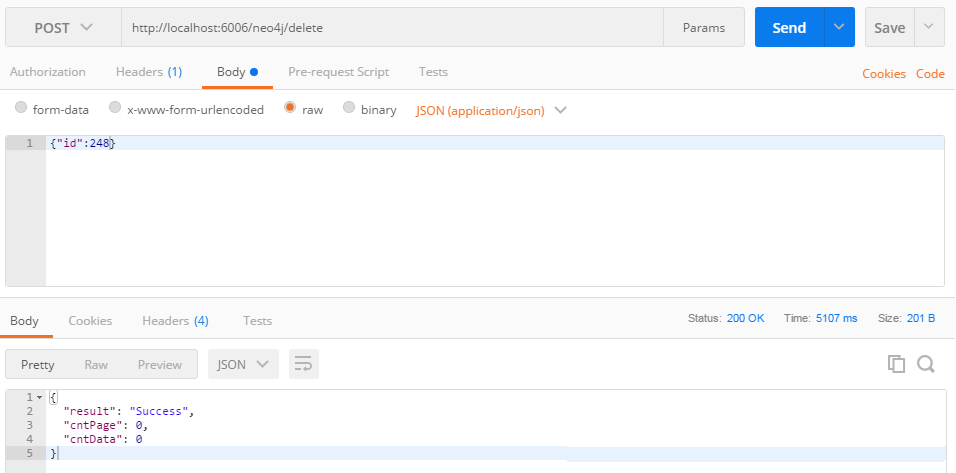
(3) 修改节点(update)
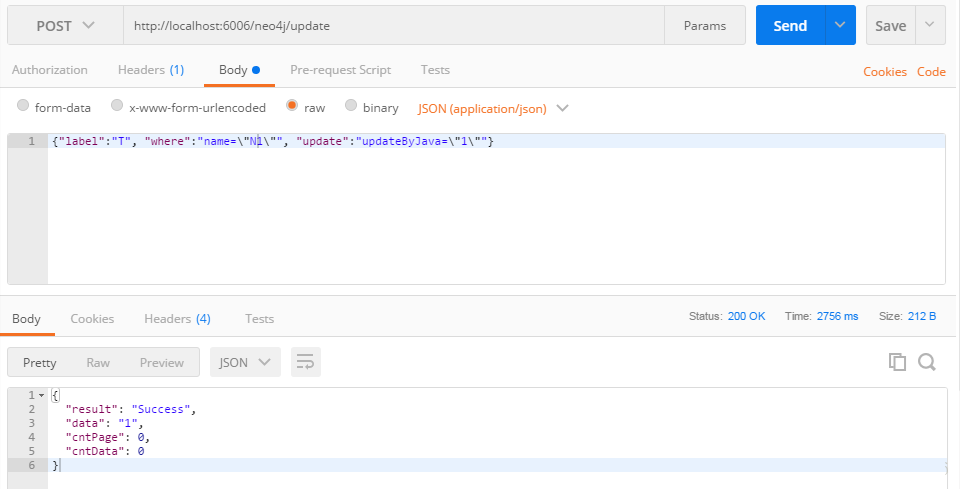
(4) 添加节点关系(relate)

(5) 自定义条件查询(search)
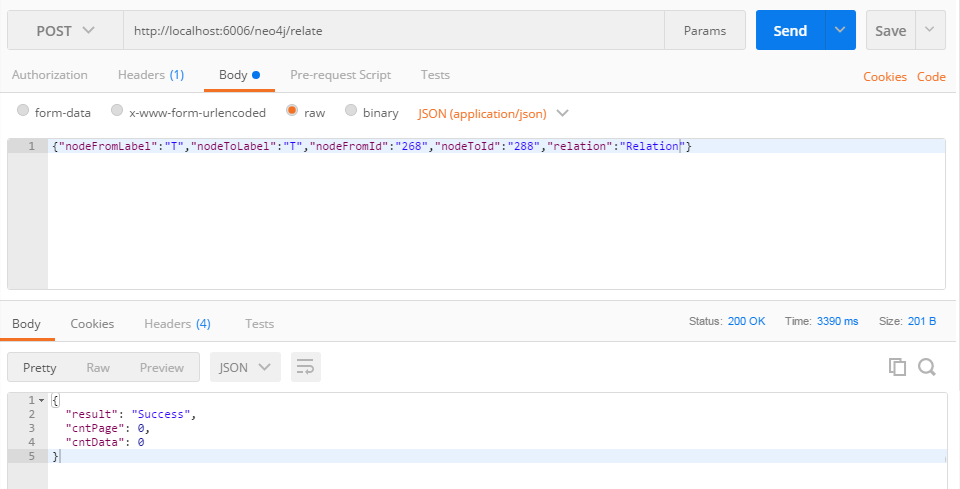
结果数据:
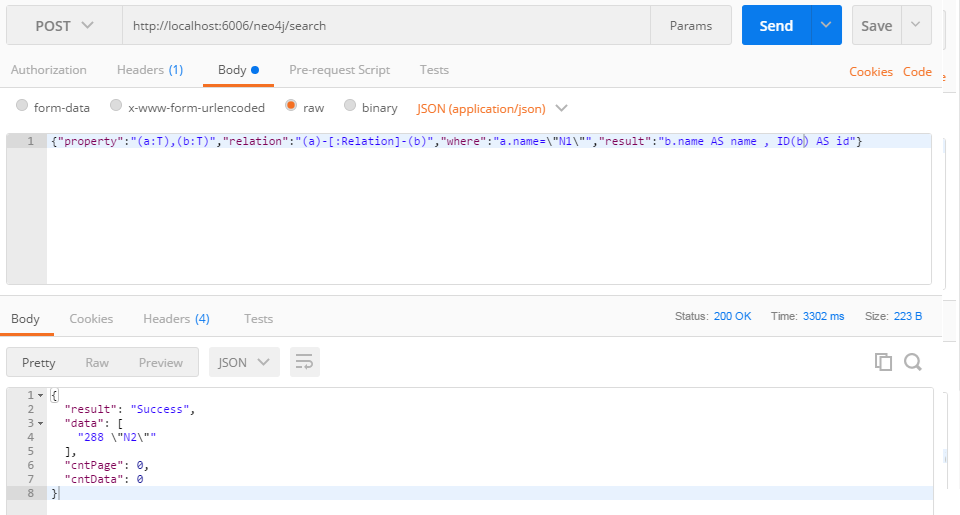
GitHub地址:https://github.com/sunroyi/neo4j.git
|